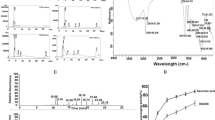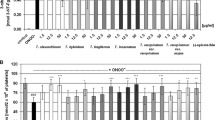Abstract
A polyphenol-rich extract from the seeds of fenugreek was evaluated for its protective effect against hydrogen peroxide(H2O2)-induced oxidation in normal and diabetic human erythrocytes (RBCs). RBCs, preincubated with increasing amounts of fenugreek seed extract and challenged with H2O2, were analyzed for hemolysis and lipid peroxidation. RBCs from diabetic subjects were more susceptible to oxidative hemolysis and lipid peroxidation than those from normal subjects. However preincubation with the polyphenol-rich extract significantly reduced the oxidative modifications in both the groups. The inhibition of lipid peroxidation was concentration-dependent up to 100 μl of extract, which contained 0.75mM gallic acid equivalent (GAE) of phenolic compounds. These findings demonstrate the potent antioxidant properties of the fenugreek seeds.
Similar content being viewed by others
References
West IC (2000) Radicals and oxidative stress in diabetes. Diabet Med 17: 171–180.
Baynes JW, Thorpe SR (1999) Role of oxidative stress in diabetic complication: A new perspective on an old paradigm. Diabetes 48: 1–9.
Santini SA, Marra G, Giardina B, Cotroneo P, Mordente A, Martorana GE, et al. (1997) Defective plasma antioxidant defences and enhanced susceptibility to lipid peroxidation in uncomplicated IDDM. Diabetes 46: 1853–1858.
Bursell SE, Clermont AC, Aiello IP, Aiello IM, Schlossman DK, Feener FP, Laffel LI, King GI (1999) High -dose vitamin E supplementation normalizes retinal flow and creatinine clearance in patients with type I diabetes. Diabetes Care 22: 1245–1251.
Maridonneau I, Braquet P, Garay RP (1983) Na + and K+ transport damage induced by oxygen free radicals in human red cell membrane. J Biol Chem 258: 3107–3113.
Rohn TT, Nelson LK, Waeg G, Quinn MT (1998) U -101033E (2,4-diaminopyrrolopyrimidine), a potent inhibitor of membrane lipid peroxidation as assessed by the production of 4-hydroxynonenal, malondialdehyde and 4-hydroxynonenal-protein adducts. Biochem Pharmacol 56: 1371–1379.
Jain SK, Levine SN, Duett J, Hollier B (1990) Elevated lipid peroxidation levels in red blood cells of streptozotocin-treated diabetic rats. Metabolism 39: 971–975.
Jain SK, Levine SN, Duett J, Hollier B (1991) Reduced vitamin E and increased lipofuscin products in erythrocytes of diabetic rats. Diabetes 40: 1241–1244.
Schwartz RS, Madsen JW, Rybicki AC, Nagel RL (1991) Oxidation of spectrin and deformability defects in diabetic erythrocytes. Diabetes 40: 701–708.
Middleton JRE, Kandaswami C, Theoharides CT (2000) The effects of plant flavonoids on mammalian cells: Implications for inflammation, heart disease and cancer. Pharmacol Rev 52(4): 673–751.
Khosla P, Gupta DD, Nagpal KK (1995) Effect of Trigonella foenum graecum (Fenugreek) on blood glucose in normal and diabetic rats. Indian J Physiol Pharmacol 39: 173–174.
Ribes G, Sauvaire Y, Costa CD, Baccou JC, Loubatieres-Mariani MM (1986) Antidiabetic effects of subfraction from fenugreek seeds in diabetic dogs. Proc Soc Exp Biol Med 182: 159–166.
Gupta A, Gupta R, Lal B (2001) Effect of Trigonella foenum graecum (fenugreek) seeds on glycaemic control and insulin resistance in type 2 diabetes mellitus: A double blind placebo controlled study. J Assoc Physicians India 49: 1057–1061.
Sharma RD (1986) An evaluation of hypocholesterolemic factor of fenugreek seeds in rats. Nutr Rep Int 33: 669–677.
Sur P, Das M, Gomes A, Vedasiromoni JR, Sahu NP, Banerjee S, Sharma S, Ganguly DK (2001) Trigonella foenum graecum (Fenugreek) seed extract as an antineoplastic agent. Phytother Res 15(3): 257–259.
Anuradha CV, Ravikumar P (2001) Restoration of tissue antioxidants by fenugreek seeds (Trigonella foenum graecum) in alloxan-diabetic rats. Indian J Physiol Pharmacol 45: 408–420.
Xia J, Allenbrand B, Sun GY (1998) Dietary supplementation of grape polyphenols and chronic ethanol administration on LDL oxidation and platelet function in rats. Life Sci 63: 383–390.
Singleton SL, Rossi JA (1965) Colorimetry of total phenolics with phosphomolybdic-phosphotungstic acid reagents. Am J Enol Vitic 16: 144–158.
Grinberg LN, Newmark H, Kitrossky N, Rahamim E, Chevion M, Rachmilewitz EA (1997) Protective effect of tea polyphenols against oxidative damage to red blood cells. Biochem Pharmacol 54: 973–978.
Tedesco I, Russo M, Russo P, Iacomino G, Russo GL, Carraturo A, Clementina F, Moio L, Palumbo R (2000) Antioxidant effect of red wine polyphenols on red blood cells. J Nutr Biochem 11: 114–119.
Niehaus WG, Samuelsson B (1968) Formation of MDA from phospholipid arachidonate during microsomal lipid peroxidation. Eur J Biochem 6: 126–130.
Drabkin DL, Austin JM (1932) Spectrophotometric studies spectrophotometric constants for common haemoglobin derivatives in human, dog, and rabbits blood. J Biol Chem 98: 719–739.
Stocks J, Dormandy TL (1971) The autoxidation of human red cell lipids induced by hydrogen peroxide. Br J Hematol 20: 95–111.
Puppo A, Halliwell B (1988) Formation of hydroxyl radicals from hydrogen peroxide in the presence of iron. Is hemoglobin a biological fenton catalyst? Biochem J 249: 185–190.
Wiseman H (1996) Dietary influences on membrane function: Importance in protection against oxidative damage and disease. J Nutr Biochem 7: 2–15.
Ravikumar P, Anuradha CV (1999) Effect of fenugreek on blood lipid peroxidation and antioxidants in diabetic rats. Phytother Res 13: 1–5.
Anuradha CV, Ravikumar P (1998) Anti -lipid peroxidative activity of seeds of fenugreek (Trigonella foenum graecum). Med Sci Res 26: 317–321.
Gupta R, Nair S (1999) Antioxidant flavonoids in common Indian diet. South Asian J Prev Cardiol 3: 83–94.
Shang M, Cais, HJ, Li J, Zhao Y, Zheng J, Namba T, Kadota S, Tezuka Y, Fan W (1998) Studies on flavonoids from fenugreek (Trigonella foenum graecum L). Zhongguo Zhong Yao Za Zhi 23(10): 614–639.
Author information
Authors and Affiliations
Corresponding author
Rights and permissions
About this article
Cite this article
KAVIARASAN, S., VIJAYALAKSHMI, K. & ANURADHA, C. Polyphenol-Rich Extract of Fenugreek Seeds Protect Erythrocytes from Oxidative Damage. Plant Foods Hum Nutr 59, 143–147 (2004). https://doi.org/10.1007/s11130-004-0025-2
Issue Date:
DOI: https://doi.org/10.1007/s11130-004-0025-2




